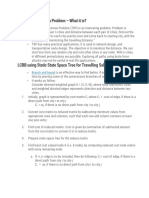0 ratings0% found this document useful (0 votes)
19 viewsMathematical Optimization: Recursive Bellman Equation
Uploaded by
Arvin HipolitoCopyright
© © All Rights Reserved
Available Formats
Download as DOCX, PDF, TXT or read online on Scribd
0 ratings0% found this document useful (0 votes)
19 viewsMathematical Optimization: Recursive Bellman Equation
Uploaded by
Arvin HipolitoCopyright
© © All Rights Reserved
Available Formats
Download as DOCX, PDF, TXT or read online on Scribd
You are on page 1/ 1
Mathematical optimization[edit]
In terms of mathematical optimization, dynamic programming usually refers to simplifying a decision
by breaking it down into a sequence of decision steps over time. This is done by defining a
sequence of value functions V1, V2, ..., Vn taking y as an argument representing the state of the
system at times i from 1 to n. The definition of Vn(y) is the value obtained in state y at the last time n.
The values Vi at earlier times i = n −1, n − 2, ..., 2, 1 can be found by working backwards, using
a recursive relationship called the Bellman equation. For i = 2, ..., n, Vi−1 at any state y is calculated
from Vi by maximizing a simple function (usually the sum) of the gain from a decision at time i − 1
and the function Vi at the new state of the system if this decision is made. Since Vi has already been
calculated for the needed states, the above operation yields Vi−1 for those states. Finally, V1 at the
initial state of the system is the value of the optimal solution. The optimal values of the decision
variables can be recovered, one by one, by tracking back the calculations already performed.
You might also like
- Dynamic Programming Is Both A: Mathematical Optimization Richard Bellman Aerospace Engineering Economics RecursiveNo ratings yetDynamic Programming Is Both A: Mathematical Optimization Richard Bellman Aerospace Engineering Economics Recursive1 page
- Variables. These Variables Provide Information For Analyzing The Possible Effects That The Current DecisionNo ratings yetVariables. These Variables Provide Information For Analyzing The Possible Effects That The Current Decision5 pages
- Process Optimisation: Dynamic ProgrammingNo ratings yetProcess Optimisation: Dynamic Programming35 pages
- Notas - Dynamic Optimation and Optimal ControlNo ratings yetNotas - Dynamic Optimation and Optimal Control26 pages
- 06DynamicProgrammingAndGreedy EditedolgaNo ratings yet06DynamicProgrammingAndGreedy Editedolga46 pages
- Dynamic Programming Presentation (Autosaved)No ratings yetDynamic Programming Presentation (Autosaved)17 pages
- Powell - Modernizing The Teaching of Optimization January 5 2024No ratings yetPowell - Modernizing The Teaching of Optimization January 5 20248 pages
- Dynamic Programming and Optimal ControlNo ratings yetDynamic Programming and Optimal Control62 pages
- Juan Camilo Alfonso 70990 Programacion DinamicaNo ratings yetJuan Camilo Alfonso 70990 Programacion Dinamica4 pages
- Unit-Iii (Part-2) Dynamic ProgrogrammingNo ratings yetUnit-Iii (Part-2) Dynamic Progrogramming42 pages
- File 1716180627 66059 DynamicProgrammingNo ratings yetFile 1716180627 66059 DynamicProgramming9 pages
- Dynamic_Programming_and_Optimal_ControlNo ratings yetDynamic_Programming_and_Optimal_Control62 pages
- CSC 344 - Algorithms and Complexity: Lecture #3 - Internal SortingNo ratings yetCSC 344 - Algorithms and Complexity: Lecture #3 - Internal Sorting33 pages
- CSC 344 - Algorithms and Complexity: Lecture #5 - SearchingNo ratings yetCSC 344 - Algorithms and Complexity: Lecture #5 - Searching31 pages
- 19 Century Philippines As Rizal's Context: The Life and Works of RizalNo ratings yet19 Century Philippines As Rizal's Context: The Life and Works of Rizal10 pages
- Republic Act 1425: The Life and Works of RizalNo ratings yetRepublic Act 1425: The Life and Works of Rizal6 pages








































































